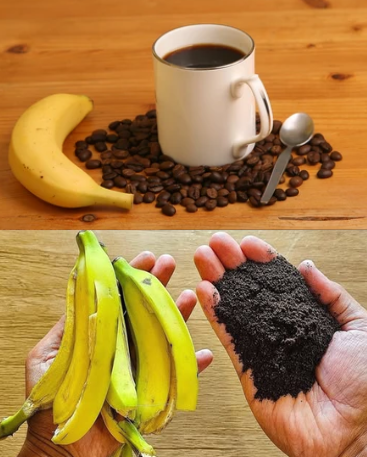
Gardening doesn’t have to mean stocking up on pricey chemical fertilizers. In fact, some of the most powerful plant foods are already in your kitchen. By combining banana peels and coffee grounds, you can create a nutrient-packed, eco-friendly fertilizer that keeps your plants thriving—all while reducing waste and saving money.
Let’s explore why this homemade fertilizer works so well, how to make it step-by-step, and how to get the most out of it.
Why Banana Peels and Coffee Grounds Are Gardening Gold
Banana peels and coffee grounds might seem like ordinary scraps, but they’re loaded with plant-loving nutrients.
- Banana Peels are rich in potassium, which strengthens plant stems, boosts disease resistance, and improves overall vigor. They also provide phosphorus for better flower and fruit production, calcium for strong root growth, and trace minerals like magnesium and manganese to enhance chlorophyll production.
- Coffee Grounds add nitrogen, an essential element for lush, green foliage. They also improve soil texture, help retain moisture, and slightly acidify the soil—perfect for plants like tomatoes, roses, and blueberries.
When combined, these two kitchen staples create a balanced fertilizer that works for both indoor houseplants and outdoor gardens.
What You’ll Need for This Homemade Fertilizer
- 3 banana peels (any ripeness works)
- 3 tablespoons of used, unsweetened coffee grounds
- 1 liter of chlorine-free water
- Blender
- Strainer or cheesecloth
- Spray bottle or watering can
Video : How to Use Eggshells, Banana Peels, and Coffee Grounds in the Garden
How to Make the Fertilizer: Step-by-Step
1. Prepare the Ingredients
Let your tap water sit uncovered for 24 hours to remove chlorine, which can harm beneficial soil microbes. Chop banana peels into small pieces and place them in the blender. Add your used coffee grounds and dechlorinated water.
2. Blend Until Smooth
Blend the mixture for about three minutes until you have a smooth, liquid consistency. This ensures nutrients are evenly distributed.
3. Strain the Liquid
Pour the blended mix through a fine strainer or cheesecloth to separate the liquid fertilizer from the pulp. The liquid is your fast-acting fertilizer, ready to be applied.
4. Apply to Plants
Transfer the liquid into a spray bottle or watering can. Pour it around the base of your plants, avoiding direct contact with leaves to prevent any residue buildup.
How Often Should You Use It?
Once a week is plenty. This allows plants to absorb the nutrients without overwhelming them. It’s suitable for all types of plants, from potted herbs to flowering shrubs.
Bonus Tip: Don’t Waste the Pulp
The leftover pulp is a slow-release fertilizer that continues to nourish your plants over time. Simply mix it into your garden soil, bury it near plant roots, or add it to your compost pile. It also feeds beneficial microbes that help keep soil healthy.
Benefits of Homemade Banana Peel & Coffee Ground Fertilizer
- Eco-Friendly – Reduces kitchen waste and cuts down on chemical fertilizer use
- Budget-Friendly – Turns free scraps into a valuable gardening resource
- Safe & Natural – Non-toxic for pets, kids, and edible plants
- Plant-Boosting Power – Encourages stronger roots, vibrant leaves, and more flowers
Mistakes to Avoid for Best Results
- Don’t use sweetened coffee grounds—sugar attracts pests like ants
- Avoid applying to completely dry soil. Lightly water first so nutrients absorb better
- Don’t overuse the fertilizer. Weekly application is enough for most plants
Video : Homemade plant fertilizers from waste! creative explained
Conclusion
This simple DIY banana peel and coffee ground fertilizer proves that powerful plant care doesn’t require a trip to the garden store. With just a blender and some kitchen scraps, you can give your plants a nutrient boost, save money, and help the planet by reducing waste.
So next time you finish your morning coffee and banana, don’t toss the leftovers—turn them into liquid gold for your garden. Your plants will thank you with healthier growth, vibrant blooms, and bountiful harvests.


